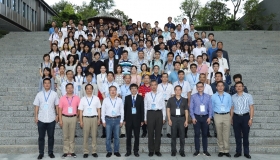News | Presentations by Prof. Marlene AMSTAD at Conferences
News | Prof. Marlene AMSTAD of School of Management and Economics Attended and Presented at 2018 Beijing Global Fintech Summit and 2018 Switzerland International Financial Forum
In November, the 2018 Beijing Global Fintech Summit, co-organized by China Finance 40 Forum (CF40) and CFCity, was convened. The summit focused on innovation and regulation. As the special guest, Marlene Amstad, vice-chair of the Board of Directors at the Swiss Financial Market Supervisory Authority and professor of practice in economics at The Chinese University of Hong Kong, Shenzhen, delivered keynote speech to illustrate the need for regulators to adopt to fintech development.
As Prof. Marlene Amstad mentioned above, regulators need to consider how to regulate those new financial participants on one hand and use new technologies developed by those market participants on the other hand.
First, Prof. Marlene Amstad offered an overview for the fintech development in Swizterland. It is diversified and will be further deepened by banking network, fintech cooperation and the innovative hub built by Swiss Federal Institute of Technology.
Second, Prof. Marlene Amstad introduced the principles of Swiss government on the regulation of technology. The Swiss Finance Market Supervisory Authority (FINMA) streamlined the procedures of fintech license application by forms, sandbox and issuing license. The major principle of FINMA’s regulation on fintech is that the same kind of risks has the same rules. Hence, there are three kinds of ICO (Initial Coin Offering), payment tokens, asset-backed tokens and functional tokens.
At last, Prof. Marlene Amstad explained how FINMA uses modern technologies to regulate market, which is mainly about two aspects : what is data collection and how to collect the data. FINMA has built a sophisticated mechanism in which they cooperate with other regulators to acquire data. It also makes good use of external resources to avoid the situation that the data is insufficient, and to exchange data at a common platform. As for the application of new technology, FINMA applies the automatic programs, which means big data and cutting-edge analysis technologies are used to improve the internal rating. It has already optimized the regulation mechanism to regulate small-scale banks, or cooperate with universities in some special cases.
Recently, the 2018 Swiss International Financial Forum was held in Zurich. Marlene Amstad, professor of practice in economics of the School of Management and Economics, The Chinese University of Hong Kong, Shenzhen, presented at the conference and gave a keynote speech, entitled “The Market Opening of China”. 
Prof. Marlene Amstad briefly introduced China’s finance market, which is comprised of the stock market and bond market. The stock market is driven by a number of individual investors, so China’s market is more volatile than the U.S. market, but the turn-over rates is higher. The key characteristic about China’s bond market is that a part of its size is amazingly diversified. When looking to the corporate bond, the GDP ratio’s is particularly lower in China compared with other countries because banks dominated the financial system in China. In terms of size, speed and potential, this market is impressive. In addition, the size of China’s free-floating equity market is around the counterpart of Switzerland. There is a broad consensus that it is beneficial for China as well as for the world to open up these capital markets. The strategy China has followed is to put investment inflows before investment outflows, and direct investment before portfolio investment. The three tools China has used for portfolio investment are quotas, connection, and index.

Prof. Marlene Amstad believed that the bridges of China’s financial market for opening up are built but the traffic on these bridges is still low, which is illustrated by looking into the foreign ownership. Chinese Rating Agencies put 80% of corporate bonds in top three rating classes (AAA, AA, A), which is highly unusual for foreign investors.
Lastly, Prof. Marlene Amstad pointed out that China’s finance market cannot be explained totally by the knowledge about how the western market worked. Now, it is the time to broaden the knowledge base about China’s finance market.
Journalist | Xu Zijin
Translator | Fiona
SME News Service
Please click the URL to watch the video: https://media10.simplex.tv/content/73/4659/108524/




